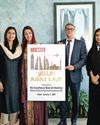
This is not going to be a university like so many other universities that exist today, said Union external affairs minister M.C. Chagla as he tabled the The Jawaharlal Nehru University Bill in the Lok Sabha on November 16, 1966. When the bill was introduced in the Rajya Sabha, on December 24, 1964, Chagla, who was former chief justice of the Bombay High Court and envoy to the US and the UK, had been the education minister.
“The object of this bill is to establish in the city of Delhi a distinctive university; a university which will not be a mere duplication of other universities but a university which will have a personality of its own, characteristics of its own, unique in many ways,” he went on to say in the Lok Sabha. It took a couple more years for the Act to come into force, leading to JNU’s establishment in 1969. But, it is no overstatement that India’s best university has become what it was meant to be, and more.
The 1,000-acre campus is housed on the rugged terrain of the Aravali hill range in Delhi. As per its vision statement, it “exemplifies the positive aspects of human habitation and intervention”. As you enter the campus, the greenery takes your breath away. The landscape is an explosion of colours thanks to the innumerable trees and shrubs. The campus, a birdwatcher’s dream, is also home to peacocks and nilgais.
The walls are decorated with posters representing different political ideologies and diverse thinking. JNU is a microcosm of India as it draws students from across the country and from different strata of society. For example, in 2022-23, of the 9,515 students, 1,428 were from scheduled castes, 677 from scheduled tribes, 3,285 from OBCs and 401 students were physically challenged. Women numbered 4,081.
This story is from the May 26, 2024 edition of THE WEEK India.
Start your 7-day Magzter GOLD free trial to access thousands of curated premium stories, and 9,000+ magazines and newspapers.
Already a subscriber ? Sign In
This story is from the May 26, 2024 edition of THE WEEK India.
Start your 7-day Magzter GOLD free trial to access thousands of curated premium stories, and 9,000+ magazines and newspapers.
Already a subscriber? Sign In

Lessons in leadership
When I began my career at Hindustan Lever (as HUL was then called), I was deeply inspired by our chairman, Dr Ashok S. Ganguly.

Political colours
One of the greatest fashion statements of recent times was made in the Parliament's winter session by Rahul Gandhi and some opposition colleagues. India's most news-making politician (since his landmark Bharat Jodo Yatra) gave up his signature white polo T-shirt for a blue one.

Chat roam
Vox pop content is seeing an uptick in India, with creators making conversations on current and social issues fun and funny

Back home with BANNG
Michelin star-winning chef Garima Arora, who recently opened her first restaurant in India, on all things food and family

One supercalifragilisticexpialidocious New Year
Once Christmas is over, tension mounts in our home as the little woman and I start ticking off the days. We both remain on edge because we dread the coming of the New Year—a time when the whole world goes crazy and adopts resolutions. We, too, make New Year promises and our ‘list of past resolutions’ is very long and impressive. Unfortunately, we are complete failures at keeping them and our ‘list of resolutions not kept’ is equally long and equally impressive.

Six or out?
Cricket is a quasi-religion in India. And our pantheon of cricketers is worshipped with a fervour bordering on hysteria.

DOWN AND UNDER THE WEATHER
After their flop show in Australia, Virat Kohli and Rohit Sharma will have to live on current form rather than past glory

The new in news
THE WEEK and DataLEADS partner to revolutionise news with fact-checks, data and Live Journalism

Hello Middle East
Reem Al-Hashimy, UAE minister of state for international cooperation, inaugurates a special Middle East section on THE WEEK website

BAIT CLICK
Dark patterns fool millions of Indians every day. The government is finally acting, but it just may not be enough